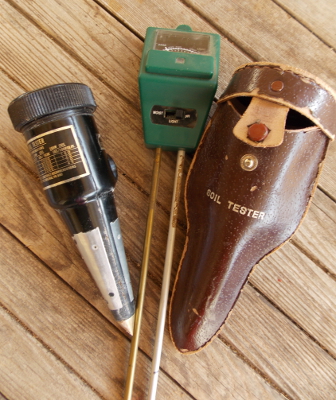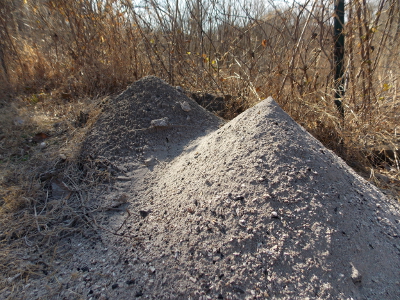
Soil pH testers
 I've always wanted to be able to test the pH
of my soil at home, since that's one soil quality I need to manage
carefully, especially around blueberries. However, the cheap pH
meter I picked up at a big-box store several years ago wasn't even worth
the few bucks I paid for it --- I could never get the device to read
anything when I flipped it to pH. So when Joey got me a fancy pH
meter at an auction, I was thrilled!
I've always wanted to be able to test the pH
of my soil at home, since that's one soil quality I need to manage
carefully, especially around blueberries. However, the cheap pH
meter I picked up at a big-box store several years ago wasn't even worth
the few bucks I paid for it --- I could never get the device to read
anything when I flipped it to pH. So when Joey got me a fancy pH
meter at an auction, I was thrilled!
The Kelway Soil Tester
certainly feels more impressive than the previous meter I'd been using,
but I'm not really sure I trust its results. In a few spots, the
Kelway Soil Tester read close enough to what my soil reports said that I
figured it was on track --- 6.8 in the blueberries where my 2012 soil
report said 6.5 (and where I wish the pH was much lower) and 6.2 in the
subsoil of the forest garden aisles where my soil report said 6.3.
But when I stuck the tester in a pile of leached wood ashes that have
been sitting out in the weather for a month or so, the first test read
5.6. Only after the day warmed up a bit more did that test come
back as 7.4, closer to the alkaline level I would expect from wood
ashes.
 That
got me wondering if temperature could play a role in pH testing. I
know that moist soil is important for getting a meter like this to
read, but lack of water isn't anything our soil suffers from at the
moment. On the other hand, our ground is half-frozen in spots,
despite a sunny week. Does anyone understand the chemistry/physics
of pH testers enough to know whether I need to wait and test when the
ground is warm? Anything else that might make a meter think wood
ashes are acidic instead of alkaline?
That
got me wondering if temperature could play a role in pH testing. I
know that moist soil is important for getting a meter like this to
read, but lack of water isn't anything our soil suffers from at the
moment. On the other hand, our ground is half-frozen in spots,
despite a sunny week. Does anyone understand the chemistry/physics
of pH testers enough to know whether I need to wait and test when the
ground is warm? Anything else that might make a meter think wood
ashes are acidic instead of alkaline?
Want more in-depth information? Browse through our books.
Or explore more posts by date or by subject.
About us: Anna Hess and Mark Hamilton spent over a decade living self-sufficiently in the mountains of Virginia before moving north to start over from scratch in the foothills of Ohio. They've experimented with permaculture, no-till gardening, trailersteading, home-based microbusinesses and much more, writing about their adventures in both blogs and books.
Want to be notified when new comments are posted on this page? Click on the RSS button after you add a comment to subscribe to the comment feed, or simply check the box beside "email replies to me" while writing your comment.

The metal plates on the outside are a tip as to how it works. The manual (pdf-file) confirms that it measures Ph by applying a small voltage difference and measuring the current through the soil.
As the manual says, the meter can be confused by saline alkaline soil. Salty water conducts electricity well, whereas demineralized water doesn't. Since wood ash contains potaassium salts, I'd say it could be considered saline, giving a erroneous reading.
So any soil that contains salts (your urine fertilizer comes to mind) could throw off the reading.
Additionally, the meter probably requires liquid water to function. I don't think ice will transport ions well...
I really appreciate your thoughtful feedback on pH meters! Here's one more from John that somehow got lost in the shuffle:
Well your website dumped my Ph comment :(.
I design electronic instrumentation. So, I have come to know a lot about Ph and other such measurements. A couple of comments:
Potential Hydrogen AKA Ph is pretty hard to measure. A mixed substrate such as soil gives big variations. Thus the lab stirrers and temperature compensation, etc. It is amazing how many folks "believe" in Ph!
Most cheap Ph meters depend on the substrate being of high conductivity which it often is not. Conductivity is apt to be VERY low, especially for wood ashes which may be dry. Or even when they are mixed with rainwater which can be VERY low conductivity and has WIDE variations at least up here near Concord, NH.
You will find very few Ph measuring devices that even claim to work on stationary samples. Most need fluid flow to mix things up, etc.
Many folks in the know think that Ph of distilled water is undefined!
And the sensors are VERY high in impedance giving other significant problems for the instrument designer.
I own a bunch and continue to be amazed at the variations the various instruments give!
Well don't want to bore you further?
More questions welcome!
Hope the above helps.
pH is a property of an aquaeous solution, I'm not a chemist but I'd suspect that dry soil doesn't even have a pH. When soil gets wet, some materials go into solution. The amount of water in the soil would have an influence on the resulting pH.
The simplest way to get a reading is probably to add distilled or demineralized water to soil (using a standard water:soil ratio) and then use indicator paper.
Anything more accurate will probably require a laboratory-like environment where you can control or at least measure things like temperature.
In chemistry class in school we did titration to determine pH. This is relatively easy and accurate when using a suitable (color) indicator. Of course you'd need an acid and base of known strength to do this. And an accurate scale.
It seems accurate glass pH electrodes are kind of finicky. They need temperature compensation as John says. They also need to be kept very clean because a dirty electrode won't work properly. A dirty or broken electrode would give a 0 mV signal which is the same as that of a neutral solution. So you need to callibrate them before use with fluids of a known pH.